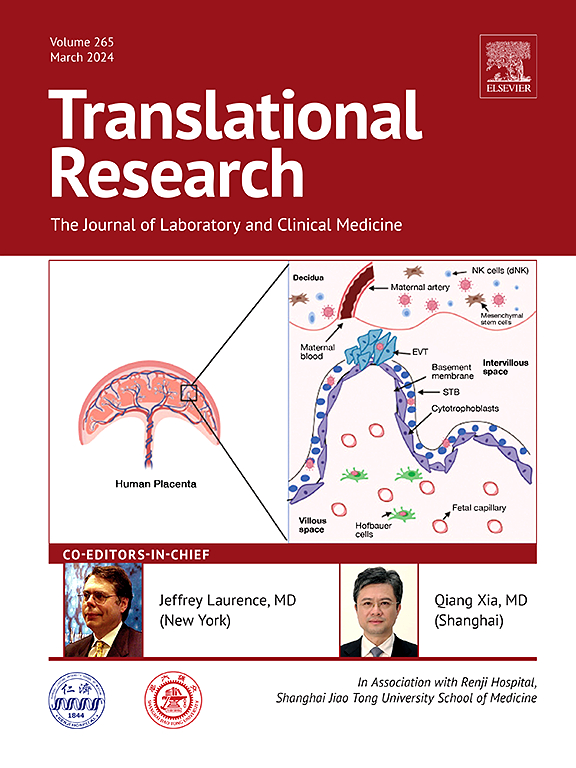淋巴-骨髓聚集浸润的 CD20+ B 细胞显示双阴性表型,与食管鳞状细胞癌的不良预后相关。
IF 5.9
2区 医学
Q1 MEDICAL LABORATORY TECHNOLOGY
引用次数: 0
摘要
根据形态特征,肿瘤浸润B细胞(TIL-Bs)可分为淋巴-骨髓聚集体(LMAs)和三级淋巴结构(TLSs)。食管鳞状细胞癌(ESCC)是一种发病率和死亡率都很高的疾病,目前有关食管鳞状细胞癌 TIL-Bs 的研究仍不清楚。因此,我们旨在研究 TIL-Bs 在 ESCC 中的预后价值和功能参与。基于对147例ESCC样本的CD20免疫组化染色,我们对不同解剖亚区域(瘤内(T)、浸润边缘(IM)和瘤周(P))的TIL-Bs进行了量化,并通过Kaplan-Meier分析将其与生存率相关联。我们发现,LMAs广泛分布于整个切片,与不良预后相关,尤其是位于T亚区的LMAs,这与TLS的积极临床意义相反。根据 LMAs 和 TLSs 的数量,构建了四级免疫类型,作为生存率的独立预测指标。通过多重免疫荧光(mIF)染色,我们发现LMAs中浸润B细胞的主要表型是CD20+IgD-CD27-双阴性(DN)B细胞。DN B细胞在ESCC肿瘤组织中含量丰富,其高表达与总生存时间缩短有关。随后,我们利用单细胞RNA-seq数据、大量RNA-seq数据和流式细胞术证明了DN B细胞和调节性T细胞(Tregs)之间的密切关系,并通过mIF染色验证了DN B细胞和Tregs的空间接近性。轨迹分析和流式细胞术显示,DN B 细胞高度表达参与抗原处理和递呈途径的基因,如 HLA-DR。ESCC 中丰富的 DN B 细胞和 LMA 为针对 ESCC 的最佳免疫疗法提供了新的潜在靶点。本文章由计算机程序翻译,如有差异,请以英文原文为准。
Lympho-myeloid aggregate-infiltrating CD20+ B cells display a double-negative phenotype and correlate with poor prognosis in esophageal squamous cell carcinoma
According to morphological features, tumor-infiltrating B cells (TIL-Bs) can be classified as lympho-myeloid aggregates (LMAs) and tertiary lymphoid structures (TLSs). As a disease with high incidence and mortality, research on esophageal squamous cell carcinoma (ESCC) TIL-Bs is still unclear. Thus, we aimed to investigate the prognostic value and functional involvement of TIL-Bs in ESCC. Based on CD20 immunohistochemical staining of 147 ESCC samples, the TIL-Bs at different anatomic subregions (intra-tumor (T), invasive margin (IM) and peri-tumor (P)) were quantified and correlated with survival by Kaplan-Meier analyses. We found that LMAs were widely distributed throughout the whole section and were associated with poor prognosis, especially those located in the T subregion, which was contrary to the positive clinical significance of TLSs. Based on the number of LMAs and TLSs, a four-level immune type was constructed as an independent predictor for survival. Using multiplexed immunofluorescence (mIF) staining, we found that the main phenotype of infiltrating B cells in LMAs was CD20+IgD−CD27− double-negative (DN) B cells. DN B cells were abundant in ESCC tumor tissue, and their high expression was related to shortened overall survival time. Subsequently, we demonstrate a close relationship between DN B cells and regulatory T cells (Tregs) using single cell RNA-seq data, bulk RNA-seq data and flow cytometry, and verified the spatial proximity of DN B cells and Tregs by mIF staining. Trajectory analysis and flow cytometry revealed that DN B cells highly expressed genes involved in the antigen processing and presentation pathway, such as HLA-DR. The abundance of DN B cells and LMAs in ESCC provides novel potential targets for optimal immunotherapy against ESCC.
求助全文
通过发布文献求助,成功后即可免费获取论文全文。
去求助
来源期刊

Translational Research
医学-医学:内科
CiteScore
15.70
自引率
0.00%
发文量
195
审稿时长
14 days
期刊介绍:
Translational Research (formerly The Journal of Laboratory and Clinical Medicine) delivers original investigations in the broad fields of laboratory, clinical, and public health research. Published monthly since 1915, it keeps readers up-to-date on significant biomedical research from all subspecialties of medicine.
 求助内容:
求助内容: 应助结果提醒方式:
应助结果提醒方式:


